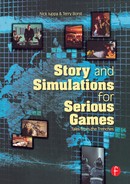Bibliography
Calica, Ben. “I Second That Emotion, or . . . Playing Games with People’s Feelings.” Gamasutra. 24 July 1998. http://www.gamasutra.com/features/game_design/rules/19980724.htm.
Campbell, John. “Adventure Developers.” Adventure Developers. 10 Apr. 2006. http://www.adventuredevelopers.com/featuredetail.php?action=view&featureid=25&showpage=1.
Driscoll, James E., and Joan H. Johnston. “Stress Exposure Training.” Making Decisions Under Stress. Ed. Janis Cannon-Bowers and Eduardo Salas. Washington, DC: American Psychological Association, 1998. 191–217.
Frame, Adela and Lussier, James W., eds. 66 Stories of Battle Command. Ft. Leavenworth, KS: U.S. Army Command and General Staff College Press, 2000.
Gordon, Andrew S. Authoring Branching Storylines for Training Applications. Proceedings of the Sixth International Conference of the Learning Sciences. Santa Monica, CA, 2004.
Gordon, Andrew S., and Nicholas V. Iuppa. Experience Management Using Storyline Adaptation Strategies. Technology for Interactive Digital Storytelling and Entertainment (TIDSE) Conference Proceedings, Zentrum Fur Graphische Datenverarbeitung E. V. Darmstadt, Germany, 2003.
Gordon, Andrew S., Mike van Lent, Martin Van Velsen, M. Carpenter, and Arnav Jhala. Branching Storylines in Virtual Reality Environments Fore Leadership Development. Proceedings of the Sixteenth Innovative Applications of Artificial Intelligence Conference. Menlo Park, CA: IAAI Press, 2004.
Hill, Randy, Jay Douglas, Andrew S. Gordon, F. Pighin, and Martin Van Velsen. Guided Conversations About Leadership: Mentoring with Movies and Interactive Characters. Proceedings of the Fifteenth Innovative Applications of Artifical Intelligence Conference. Menlo Park, CA: IAAI Press, 2003.
Iuppa, Nicholas V., Gershon Weltman, and Andrew S. Gordon. Bringing Hollywood Storytelling Techniques to Branching Storylines for Training Applications. Narrative and Interactive Learning Environments Proceedings. Edinburgh, Scotland, 2004.
Jhala, Arnav, and Michael Young. A Discourse Planning Approach to Cinematic Camera Control for Narratives in Virtual Environments. Proceedings of the National Conference of the American Association for Artificial Intelligence. Pittsburgh, PA, 2005.
Johnson, Bill. A Story is a Promise: Good Things to Know Before You Write That Screenplay, Novel, or Play. Blue Heron Publishing, 2000.
Kirlik, Alex, Arthur D. Fisk, Neff Walker, and Ling Rothrock. “Feedback and Practice.” Making Decisions Under Stress. Ed. Janis Cannon-Bowers and Eduardo Salas. Washington, DC: American Psychological Association, 1998. 91–113.
Lippman, John. “As Hollywood Casts About for a War Role, Virtual Reality is Star.” Wall Street Journal 9, Nov. 2001, sec. A: 1+.
Longyear, Barry. Science Fiction Writer’s Workshop—I: An Introduction to Fiction Mechanics. Philadelphia, PA: Owlswick Press, 1980.
Magerko, B. Story Representation and Interactive Drama. Proceedings of the 1st Artificial Intelligence and Interactive Digital Entertainment Conference. Marina Del Rey, CA, 2005.
Magerko, B. and Laird, J.E. Mediating the Tension Between Plot and Interaction. AAAI Workshop Series: Challenges in Game Artificial Intelligence. San Jose, CA, 2004. 108–112.
McKee, Robert. Story: Substance, Structure, Style and the Principles of Screenwriting. Regan Books, 1997.
Murray, Janet. Hamlet on the Holodeck. Free Press, 1997.
Stephenson, Neal. The Diamond Age. Spectra, 1995.
Sternberg, Robert, et al. Practical Intelligence in Everyday Life. Cambridge University Press, 2000.
